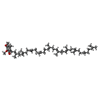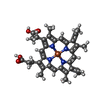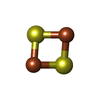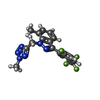+Search query
-Structure paper
| Title | Rieske head domain dynamics and indazole-derivative inhibition of Candida albicans complex III. |
|---|---|
| Journal, issue, pages | Structure, Vol. 30, Issue 1, Page 129-138.e4, Year 2022 |
| Publish date | Jan 6, 2022 |
 Authors Authors | Justin M Di Trani / Zhongle Liu / Luke Whitesell / Peter Brzezinski / Leah E Cowen / John L Rubinstein /   |
| PubMed Abstract | Electron transfer between respiratory complexes drives transmembrane proton translocation, which powers ATP synthesis and membrane transport. The homodimeric respiratory complex III (CIII) oxidizes ...Electron transfer between respiratory complexes drives transmembrane proton translocation, which powers ATP synthesis and membrane transport. The homodimeric respiratory complex III (CIII) oxidizes ubiquinol to ubiquinone, transferring electrons to cytochrome c and translocating protons through a mechanism known as the Q cycle. The Q cycle involves ubiquinol oxidation and ubiquinone reduction at two different sites within each CIII monomer, as well as movement of the head domain of the Rieske subunit. We determined structures of Candida albicans CIII by cryoelectron microscopy (cryo-EM), revealing endogenous ubiquinone and visualizing the continuum of Rieske head domain conformations. Analysis of these conformations does not indicate cooperativity in the Rieske head domain position or ligand binding in the two CIIIs of the CIII dimer. Cryo-EM with the indazole derivative Inz-5, which inhibits fungal CIII and is fungicidal when administered with fungistatic azole drugs, showed that Inz-5 inhibition alters the equilibrium of Rieske head domain positions. |
 External links External links |  Structure / Structure /  PubMed:34525326 PubMed:34525326 |
| Methods | EM (single particle) |
| Resolution | 3.0 - 3.3 Å |
| Structure data | EMDB-24482, PDB-7rja: EMDB-24483, PDB-7rjb: EMDB-24484, PDB-7rjc: EMDB-24485, PDB-7rjd: EMDB-24486, PDB-7rje: |
| Chemicals |  ChemComp-HEM:  ChemComp-U10:  ChemComp-HEC:  ChemComp-FES:  ChemComp-ZL5: |
| Source |
|
 Keywords Keywords | MEMBRANE PROTEIN / Candida albicans / mitochondrial complex III2 / indazole-derivative inhibitor / Rieske head domain |
 Movie
Movie Controller
Controller Structure viewers
Structure viewers About Yorodumi Papers
About Yorodumi Papers













 Candida albicans SC5314 (yeast)
Candida albicans SC5314 (yeast)